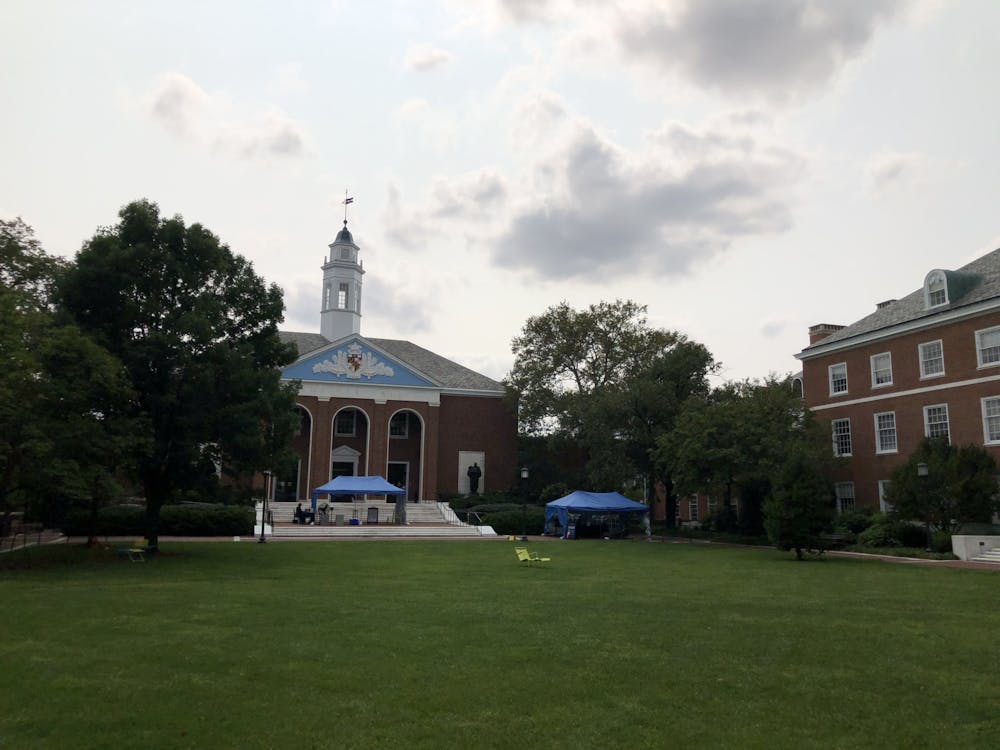The University released a dashboard on Monday to track coronavirus (COVID-19) cases confirmed through the Johns Hopkins COVID-19 Call Center (JHCCC) and regular testing of students living on campus. Contact tracing is not part of the website.
In addition, the University is launching an epidemiological surveillance study that will test volunteered participants regularly to better monitor the spread of the COVID-19 on the Homewood Campus. University affiliates can apply to be part of the study by Sept. 30. Testing data from the study will also be included in the dashboard.
The University previously announced plans for a COVID-19 dashboard and the epidemiological study on August 25. The dashboard was supposed to be released by August 31, the first day of the fall semester. Similar online portals at peer institutions, such as the University of Notre Dame, have been live since August.
Sophomore Tangya Tan believes that the dashboard should have been released earlier.
“School has already started for three weeks. A lot of students were returning to campus earlier. Having a dashboard is way too late for students who were already here,” she said. “It’s a little irresponsible to put students into this situation.”
Junior Leland Held stated that he was unaware that the dashboard had been released.
“I didn’t know they released it when they did, so it would have been nice if it was well known,” he said. “As for timing, it’s better late than never.”
There was no official communication from the University about the dashboard until the Sept. 16 Office of Communications email to subscribed Hopkins affiliates.
In an email to The News-Letter, Vice Provost for Student Health and Well-Being Kevin Shollenberger explained that the University recently consolidated its response to COVID-19 to JHCCC to better facilitate data collection.
“We have been tracking and monitoring the number of tests and the results since the very beginning of the pandemic,” he wrote. “It took some time to merge, automate, and validate the systems.”
Shollenberger further noted that the JHCCC is primarily focused on alerting individuals who have made meaningful contacts with University affiliates who tested positive and would not provide contact tracing information online.
Since the beginning of the semester, the University has administered 1,174 tests to 968 people, according to the dashboard; there were 50 total positive tests. Last week, there were 25 positive tests out of 590 tests administered to 479 people.
The dashboard numbers are updated every Monday, breaking down testing data between students and faculty/staff. It does not provide separate data points based on campuses.
Students expressed concerns about the accuracy of the data on the dashboard.
After arriving in Baltimore, Tan decided to get tested for COVID-19 outside of the JHCCC system. She stressed that the University’s dashboard excludes important data.
“I’m concerned how accurate the dashboard is because it doesn’t include people like me who got tested on their own,“ she said.
Many students who have returned to Baltimore have been getting tested outside the JHCCC system. There are several designated testing locations throughout Baltimore as well as a few mobile testing sites.
Since arriving in Baltimore in August, junior Mario Aguirre has received four COVID-19 tests from Baltimore testing facilities. He echoed Tan’s concern that the dashboard does not provide meaningful data on students living in Charles Village in an email to The News-Letter.
“While the dashboard is useful for seeing new cases in staff and students in JHU housing, it is only updated once a week, which is inconvenient,” he wrote. “The bigger problem is that the dashboard does not account for the students living off-campus. That population is significant and is vulnerable as there are less robust testing standards and contact tracing for off-campus students.”
Aguirre believes that the University should expand testing to students in off-campus housing.
“Hopkins should offer testing for students living in Charles Village and integrate that data into the dashboard so students and other Charles Village residents are safer,” he wrote.
The University currently does not provide regular testing to students living in off-campus housing. Students in off-campus housing can only get tested through the JHCCC system if they exhibit symptoms that meet the criteria set by the University’s infection control team.
Junior Ranjani Ramasubramanian called on the University to expand testing efforts to include asymptomatic testing for students living in off-campus housing.
“What would make the dashboard more effective is if we had asymptomatic testing so people can go testing if they have the slightest inkling that they have COVID. A lot of people have those fears but are not testing,” she said. “For all we know, they could have COVID, so the dashboard numbers are just not accurate.”
Vice Provost and Chief Risk and Compliance Officer Jonathan Links clarified in an email to The News-Letter that the study will involve up to 100 residential undergraduate students, 100 students residing in Charles Village and 100 staff and faculty who are engaging in Phase One activities on campus.
Ramasubramanian further noted the limitations of the epidemiological surveillance study given that participants are volunteers.
“A lot of students who have been participating in risky behavior — and there are a lot of those in off-campus housing — would not want to be part of this. I don’t think it will give an accurate representation,” she said. “It should be mandatory for anyone staying off-campus to be tested once a week, so it's an everyone thing, not an option thing on a limited scope.”
Tan, however, argued that the University should not make testing mandatory for students in off-campus housing but instead provide transportation to COVID-19 testing sites in Baltimore if it is unable to provide asymptomatic testing.
“Getting testing is your decision. But the school should make the option available for testing for people who want it,” she said. “If the University doesn’t provide testing, it would be great if they could at least provide transportation for students who want to be tested.”





